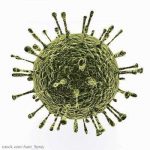When an E. coli outbreak at the Twisted Fork in Reno, Nevada was linked to a dessert item prepared by another company, many people wondered: what can it be? Something containing fresh berries? Something made from unpasteurized dairy? Was it undercooked ground beef? Nope. It turns out that the chocolate mousse made for the restaurant by Reno Provisions that gave 22 people E. coli infections was contaminated when a blender used for meat was not cleaned properly before it was used again to make the mousse. Washoe County District Health Officer Kevin Dick said in a statement, "several people who ate at the Twisted Fork restaurant had the dessert, as did some other people outside the Reno area who then developed the E. coli infection. That commonality led investigators to the dessert … [Read more...]
Consumer Food Handling Leads to Cross-Contamination
A new peer-reviewed article by Jeannie Sneed, et al, published in Food Protection Trends says that consumer food handling practices lead to cross-contamination. Although outbreaks that sicken multiple persons are usually linked to mass produced foods or restaurants, about 9 to 15% of most foodborne illnesses occur in the home. The study looked at the "Food Safe Families" clean and separate messages and to determine the impact of external safe food handling cues. One hundred-twenty-three parents who were between 20 and 45 years of ago, who prepared four or more meals at home each week, and had at least one child less than 13 years old in the home were studied. Two experimental groups were educated about safe food handling; one through traditional food safety messages, the other through … [Read more...]
Wash Your Hands to Prevent Foodborne Illness!
Most food poisoning cases happen in the home. Why? Research from Kansas State University finds that 90% of home chefs violate food safety rules, especially rules about hand washing and cross-contamination. Cross-contamiantion happens when hands are not washed after handling raw meats, when cutting boards and utensils are used for fresh foods after coming into contact with raw meats, and when preparing food. The study was conducted to discover which type of food safety education resulted in the best food safety practices. One hundred twenty three participants were divided into three groups. The first group was told about the food safety campaign messages of "clean, separate, cook, and chill." The second group looked at pubic service announcements on this message, and the third did not … [Read more...]
USDA Offers Food Safety Tips for Fourth of July Celebrations
The USDA is offering food safety tips for Americans celebrating Independence Day. Salmonella infections can happen if you serve unsafe food that is not handled or prepared correctly. First, make sure you separate raw meat products from ready to eat raw foods in your shopping cart and on the way home. Put raw meat into bags and containers separate from produce, snack foods, and breads. Keep them separate in the fridge and as you prepare the food too. Always cook hamburgers to 160°F as measured by a food thermometer. Wash your hands before preparing food and often while working in the kitchen. And keep food cool; always refrigerate perishable foods within 2 hours at room temperature; one hour if the ambient air temperature is above 90°F. The only way of ensuring doneness of meats and … [Read more...]
Handling Produce Safely: Ashley Eisenbeiser
Earlier this month, the Partnership for Food Safety Education held a webinar on handling produce safely. Since Salmonella-contaminated produce is in the top five pathogen-food combinations that cause food poisoning outbreaks, knowledge is critical. Ashley Eisenbeiser of the Food Marketing Institute spoke about the numbers. Produce is responsible for 46% of reported foodborne illness outbreaks from 1998 to 2008, and caused 23% of deaths in those outbreaks. Overall, leafy vegetables cause 8% of those illnesses. Of outbreaks attributed to produce, 30% are caused by cross-contamination, and 40% to poor personal hygiene; the rest are contaminated at the source. Sixty-eight percent of outbreaks attributed to produce are from food purchased from a restaurant or deli, 9% from private homes, 7% … [Read more...]
Eating At the Mall? You Might Want to Bring Wet Wipes
Everyone has eaten at food courts in shopping malls. They're convenient places to grab a quick bite to eat. The food might not be gourmet, but it's usually pretty good. But have you ever wondered about the food safety at food court dining establishments? When I was younger, my mom would always have wet wipes in her purse, and she wiped down the tables before we sat down to eat. Turns out she was ahead of her time. A new study published in Epidemiology and Infection has found that the food court at shopping malls are a potential transfer point for pathogenic microbes. Bacteria was found on tables and on the cleaning cloths used on them. The bacteria on the cloths was pathogenic, and was found on the tables, suggesting cross-contamination. In other words, the rags and cloths used to … [Read more...]
Funeral Salmonella Case in West Alabama from Cross-contamination
Cross-contamination during meal time is probably what caused a virulent outbreak of Salmonella in the west Alabama town of York. Dr. Mary McIntyre, assistant state health officer for disease control and prevention , said at least 67 people are affected from as many as 10 states because the July 6 meal they shared was at a heavily visited Eastern Star Baptist Church funeral. “If you attended this event and are ill, please contact your physician,” McIntyre said in a news release from Montgomery, Alabama. She said several people continue to be hospitalized, some in serious condition. The task of investigators has been complicated by the fact that many funeral-goers went to hospitals in their home states -- at least 10 outside Alabama. According to the Alabama Bureau of Clinical … [Read more...]
Got Pepper? You May Have Salmonella Too
Many foods we don't think about when considering food poisoning can, in fact, be contaminated with pathogenic bacteria. For instance, not many people know that all foods containing raw flour should be baked, since that product can be contaminated with bacteria. And a study published in Food Microbiology ahead of print for May 2013 looked at the growth and survival of Salmonella in ground black pepper. In the past, spices have been recalled for bacterial contamination, usually Salmonella. In December 2011, there was several recalls of organic celery seeds for possible Salmonella contamination, and in January 2012, Jones' Seasoning recalled their Mock Salt for possible Salmonella contamination. In the study, scientists inoculated ground black pepper with a cocktail of Salmonella, then … [Read more...]
Dishwashers No Match For Norovirus
What do norovirus and baked-on lasagna have in common? Both can survive the dishwasher. Researchers at Ohio State University have made a discovery that may help to explain why restaurants have a hard time controlling the spread of norovirus, the leading cause of food poisoning worldwide. About half of all foodborne illness outbreaks in the US are caused by norovirus, most of them, about 80 percent, happen between November and April, according to the Centers for Disease Control and Prevention (CDC). Norovirus is a virus that can get on food at any point from farm to table. Foods that are eaten raw are such as leafy vegetables, fruit, and shellfish, are most commonly involved in norovirus outbreaks. Sick food handlers are frequently the source of outbreaks such as the recent Salmonella … [Read more...]
The Best Way To Clean Up After Food Poisoning Strikes
What's the best way to clean up after someone in your household gets sick from food poisoning? A two-step method of wiping down surfaces with soap and then a bleach solution is best, according to a new a new study published in the November issue of the Journal of Applied and Environmental Microbiology. One way people become sick during foodborne illness outbreaks is from secondary spread, meaning germs from someone who is sick make other people sick. Unseen germs from diarrhea or vomit can contaminate surfaces in the bathroom which pose a risk for others who use the same facilites. Researchers Era Tuladhar, Wilma C. Hazeleger, Marion Koopmans, Marcel H. Zwietering, Rijkelt R. Beumer, and Erwin Duizer contaminated surfaces with a variety of bacteria including Salmonella and … [Read more...]













